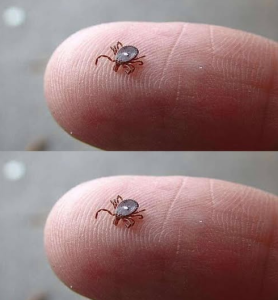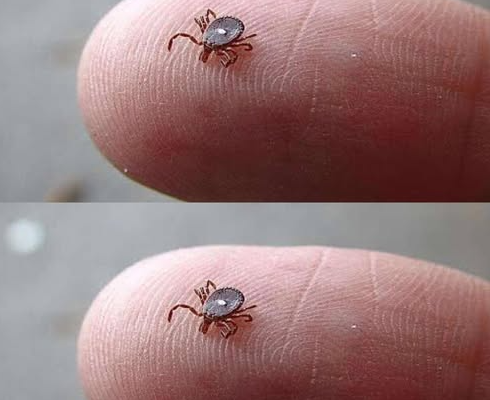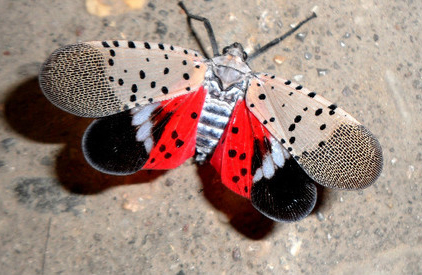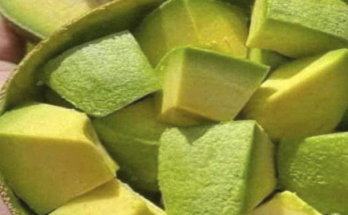
Sometimes, what looks like a pretty insect on your porch or garden could actually be a serious threat to your home, crops, or even your local ecosystem. One such bug has been drawing urgent warnings from environmental officials in the U.S. and beyond: the spotted lanternfly.
At first glance, this insect is quite striking. Its delicate spotted wings and bright red underwings make it stand out. But behind that colorful appearance lies a destructive pest capable of harming trees, crops, and plants — and even destabilizing local agriculture. If you ever spot this insect, it’s important to know exactly what steps to take.
🪰 What Is the Spotted Lanternfly?
The spotted lanternfly is an invasive planthopper native to parts of Asia. It was first detected in the United States in 2014 and has since spread rapidly across several states. Unlike native insects, it has few natural predators in North America, which means its population can explode quickly if left unchecked.
Adult lanternflies are about 1 inch long and half an inch wide. They have:
-
Grayish forewings with black spots
-
Bright red underwings with black spots
-
Black legs and head
-
A tendency to hop or glide when disturbed
While they don’t bite or sting humans, they cause major damage to plants and trees by feeding on sap and leaving behind a sugary substance called honeydew, which encourages mold growth.
🌿 Why This Insect Is a Big Problem
The spotted lanternfly isn’t just a nuisance — it’s a serious environmental and economic threat. Here’s why experts are so concerned:
-
Agricultural Damage
This pest feeds on more than 70 types of plants, including:-
Grapevines
-
Fruit trees (apple, peach, cherry)
-
Maple, walnut, and oak trees
-
Ornamentals and hardwoods
Vineyards are especially vulnerable. Entire crops can be wiped out if infestations go unchecked.
-
-
Tree Weakening and Death
By sucking sap from trunks, branches, and stems, the insect weakens plants over time. Trees may not die immediately but become more vulnerable to disease and drought. -
Sticky Residue and Mold
The honeydew they excrete attracts ants, wasps, and promotes sooty mold. This black mold can coat patios, cars, furniture, and even home exteriors, making infested areas unpleasant to live in. -
Rapid Spread
Lanternflies lay eggs on nearly any surface — tree bark, outdoor furniture, firewood, cars, or even clothing. That means they can hitchhike across states and spread very quickly.
🚨 How to Identify an Infestation
Knowing what to look for can help you act early before the problem gets out of hand. Signs include:
-
Clusters of eggs that look like a smear of mud or putty on trees, vehicles, rocks, or outdoor objects.
-
Nymphs (young lanternflies) that are black with white spots in early stages, turning red and black as they mature.
-
Adults congregating on trees or plants, often in large numbers.
-
Sticky residue on patios, walkways, cars, or tree bark.
-
Black mold developing on surfaces beneath infested trees.
If you see one or more of these signs, it’s crucial to act quickly.
🧭 Step-by-Step: What to Do If You Spot One
1. Don’t Ignore It
Many people brush off the sight of a spotted lanternfly, thinking it’s just another bug. But every single insect matters. Even one can lay eggs and start a new infestation.
2. Take a Photo or Video
Documenting what you see is important. Get a clear photo of the insect, egg mass, or nymph. This will help local authorities verify the sighting and track its spread.
3. Report the Sighting
Most states in the U.S. have hotlines or online reporting systems for invasive pests. Reporting helps officials map infestations and coordinate control measures.
-
Search your state’s agriculture department website for “spotted lanternfly reporting.”
-
Many states offer simple online forms or smartphone apps.
-
Provide your location and attach the photo.
4. Kill the Insect if Possible
While it may sound harsh, agricultural experts strongly encourage people to kill the lanternfly if they encounter one.
The insect is invasive and poses a significant threat, so:
-
Stomp it firmly if it’s on the ground.
-
Use a fly swatter or similar tool.
-
Avoid using chemical sprays unless advised by professionals, as they may harm beneficial insects too.
5. Destroy Egg Masses
If you find what looks like a patch of eggs:
-
Scrape them off with a hard card or putty knife.
-
Collect the eggs in a plastic bag.
-
Add hand sanitizer or rubbing alcohol to kill them.
-
Seal the bag tightly and dispose of it.
Never just scrape eggs onto the ground — they will hatch and worsen the problem.
6. Check Your Belongings
Because eggs and nymphs can hitchhike, check:
-
Cars and bumpers
-
Outdoor furniture
-
Camping gear and firewood
-
Boat trailers and RVs
-
Clothing and bags
If you’re traveling from an infested area, inspect everything before moving.
7. Limit Movement of Infested Materials
Firewood, vehicles, and equipment can unknowingly carry lanternflies or their eggs. Many states have quarantine zones in place. If you live in or near one, follow local rules on what can be moved and where.
🧪 Natural and Professional Control Methods
Natural Steps for Homeowners:
-
Tree bands: Sticky traps wrapped around tree trunks can catch nymphs climbing.
-
Pruning: Remove or treat infested branches.
-
Encouraging predators: Birds and some insects may help reduce populations (though they won’t eliminate them entirely).
Professional Pest Control:
If the infestation is severe, pest control specialists may use:
-
Systemic insecticides (applied to trees)
-
Targeted spraying
-
Egg mass treatment during winter months
Always follow local guidelines to avoid harming beneficial wildlife or pollinators.
🧠 Prevention Is Key
The best defense against the spotted lanternfly is stopping it before it spreads further. Simple steps can make a difference:
-
Stay informed about local alerts.
-
Don’t move untreated firewood between regions.
-
Inspect vehicles when traveling.
-
Educate neighbors — community efforts are powerful.
-
Plant a variety of trees and plants to support healthy local ecosystems.
🌍 The Bigger Picture: Why This Matters
While one insect might not seem like a big deal, invasive species like the spotted lanternfly can reshape entire ecosystems. In states where it has already taken hold, vineyards have lost millions of dollars in crops. Trees weakened by infestations can collapse more easily during storms. Neighborhoods become coated in sticky residue, attracting pests and mold.
By taking action — even just reporting a sighting — you become part of a bigger defense network that helps protect forests, farms, and communities.
🪴 Other Insects Worth Watching
The spotted lanternfly isn’t the only invasive pest to be cautious about. Others include:
-
emerald ash borer — a beetle devastating ash trees across North America.
-
Asian longhorned beetle — an insect that bores into hardwood trees.
-
brown marmorated stink bug — notorious for damaging crops and invading homes.
Being observant and proactive helps slow the spread of all invasive species.
🟢 Final Thoughts: A Small Action With a Big Impact
Spotting one insect might seem insignificant — but when it comes to the spotted lanternfly, every sighting matters. By learning how to identify it, report it, and take swift action, you help protect your neighborhood, local wildlife, and entire industries from a costly and damaging invader.
So if you ever see that distinctive spotted wing or a suspicious mud-like patch of eggs, remember:
-
📸 Take a picture
-
🚨 Report it
-
🪓 Kill or remove it safely
-
🌱 Check your belongings to stop the spread
A few minutes of attention could save thousands of trees and millions of dollars in damage. Nature can’t fight this pest alone — but together, communities can.




